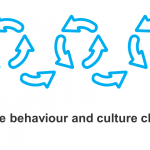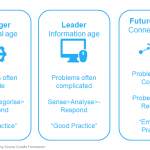“We get it, but it’s just too simple.”
That’s a comment we sometimes hear when working with senior leaders when we suggest using agile principles to create enduring behavioural, performance or cultural change.
The agile principles and approaches we are describing share some common characteristics:
- They are bottom up, people centric activities that fosters diverse input, wide buy-in and engagement of those involved.
- They have an intense focus on a small priority area, which leads to rapid and near continuous value delivery.
- They focus on experimentation and learning, uncovering unknown solutions and reducing risk by quickly dropping ideas that don’t work.
- There is a high value placed on sharing and transparency around what works and what failed, further accelerating learning and building trust
Applying these and similar principles by adopting sprints, stand-ups and other agile-like ideas across your teams is pretty simple.
 But the hard bit, the bit that requires real effort, is displacing the often deeply embedded organisational and personal conditioning that can hinder them being effective. More often than not, this is the area where we help clients the most.
But the hard bit, the bit that requires real effort, is displacing the often deeply embedded organisational and personal conditioning that can hinder them being effective. More often than not, this is the area where we help clients the most.
So what do I mean by conditioning? It’s simply what we’ve got used to over time, and unconsciously feels normal to us – I’ve written about this before here. Not doing things the way we have been conditioned can also feel very uncomfortable. For leaders and organisations, this conditioning can look like:
Thinking hierarchically when it comes to information and ideas
For many of us, spending time within historically hierarchical organisations, we get used to thinking the high-ups should have more information. After all, as we become more senior, people ‘report to us’ with their information, we gain access to all sorts of (privileged) business information and outside input from consultants and other advisors, there is often a strong need-to-know culture and we assume that all our experience and knowledge must be worth more than our junior colleagues when it comes to insight and ideas.
For agile approaches to work, there has to be a culture of transparency, sharing and multi-way feedback which can be pretty uncomfortable when you have been conditioned not to expect it.
As senior leaders we feel we should know the answers
We’ve also been conditioned as we become more senior to feel we should know the answer, when in reality as complexity and rate of change increases, it’s increasingly difficult to be sure of anything. Agile focuses not on ‘answers’ but on ideas to test quickly, often failing, but failing fast – and importantly learning from that failure before trying something else.
As senior leaders we make big plans and expect to get them implemented
We are often conditioned to come up with big, long term plans to implement decisions and ideas. Sometimes this takes months and the plans themselves can be spread over years – so called Big Design Up Front. The problem is, even if we were ‘right’ when we made the plan (see above!), the world is changing so fast, the plan can quickly be outdated.
Not only that, those implementing the plan can often feel ‘done to’, leading to poor engagement and ongoing performance, particularly when they can see, on the front line, what is working and what is not.
Agile approaches certainly rely on a vision and general direction, but after that they iteratively work on whatever the priority task is, meaning they can change direction (pivot) quickly in the light of changing circumstances and feedback.
As senior leaders we are not expected not fail
In many corporate cultures fear of failure is often the main barrier to experimentation. Asking for budget to ‘give something a go’ which you have no idea will work is not the norm.
In contrast, we know that around 90% of start-ups fail, but they usually fail fast and early. Agile reframes failure into learning, and it manages risk by limiting the potential failure to very small units of effort.
It is no surprise that we observe many startups and startup founders, often unencumbered by this type of conditioning (ie previous top down organisational thinking), seem to adopt and thrive with agile approaches far more readily.
So what things can we try?
- Be aware of your own conditioning – be honest with yourself about how you really feel
- Beware of the HiPPO – the highest paid person’s opinion.
- Reframe failure as an opportunity for learning both for others and yourself.
- Share more information – switch your default thinking to what should you NOT share, rather than to what you could share.
- Trust more.
- Treat your team like adults, and expect them to act like adults.
Overcoming senior and middle management conditioning using behavioural science and understanding is often the key to unlocking improved agility within organisations. It’s often the hard bit that needs outside help, effort and time to achieve.
If you’d like to enable your leaders to better understand and overcome the individual and organisation conditioning that’s preventing greater agility, then call Simon on 020 3488 0464 or email simon@simonwalker.org








